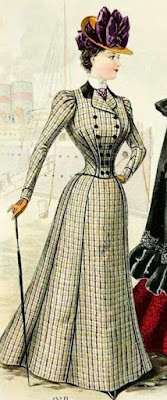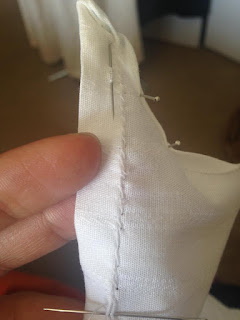18th Century Strapless Stays Part: I
With my unit's Rev. War reenactment coming up next month, I thought now would be a great time to finally make my first pair of stays.
Thanks to a good friend of mine, the pattern I am using is from J.P. Ryan's strapless stays. The pattern is very easy to follow with no worries about tiny pattern pieces, or difficult to read instructions. I'm thinking of possibly doing a review about it later on down the road when I make another stays with straps (that way I can make some comparisons).
Now that everything's finally cut out, basted, and machine sewn, I ironed down all of the seams and pinned the fashion fabric and interface together for more sewing later.
When I first started my construction, I used 1 of the 2 yards of the fabric I bought from the 18th century market fair two weeks ago. The fabric is a beautiful and durable heavy duck canvas that I figured would work for this project; that and as soon as I saw it on the sales table, I knew that I'd had to have it.
Now for the fun part! After a few hours of tracing and cutting the linen fabric that I had laying around, I started piecing everything together to get the right shape. Once I was comfortable with it, I sewed the fabric together so it would be my lining. However, there was something I failed to realize: the pattern called for interfacing, in order to keep it stiff. The only interfacing that I had available was the modern iron-on interface that I planned to use for my husband's Regency Tailcoat (aka Mr. Darcy Coat), so after doing some research and asking friends for advice, the only answer was to make the interface out of the leftover duck canvas.
 |
| I traced and cut these out 4 times for my interfacing and fashion fabric |
 |
| The finished interface; I accidentally messed up on one of the panels, but since this going to be mostly hidden by the fashion fabric, no harm no foul. |
 |
| The fashion fabric opened butterfly-style. |
Looking back at the semi- finished product, a few things will probably occur over the next few days. I'll have to look online for metal boning (as well as what kind of boning I want to go with), find a busk that will help the stays stay flat in the front, as well as to start marking the interface for the boning channels. I'm also contemplating on the color of the binding tape that's going to go all around the stays. I was thinking of using either light brown or black to make everything match elegantly.
In retrospect, I really like this pattern because of how easy it is to follow, plus the entire construction itself was easy once I really got into it. I can't wait to see the final product once it's finished.





.jpg)


Comments
Post a Comment